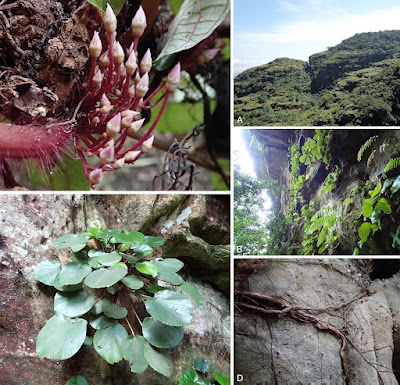 |
| Benna alternifolia Burgt & Ver.-Lib., in van der Burgt, Haba, Magassouba et Veranso-Libalah, 2022. DOI: 10.3372/wi.52.52102 |
Abstract
Benna is a new monospecific genus in the Melastomataceae, from the Benna Plateau in Forécariah Prefecture in Guinea, West Africa. Molecular sequence data show the genus Benna is nested within the tribe Sonerileae but clearly unrelated to the other African Sonerileae genera. The genus is weakly supported as sister to the South American Sonerileae genus Phainantha. Similarities and differences with African and American Sonerileae genera are listed. The new species Benna alternifolia is a perennial evergreen herb, half-spherical in shape, up to 1.2 m in diameter. A plant may have up to 60 alternate leaves, with petioles up to 45 cm long and blades up to 31 × 28 cm. The flowers are actinomorphic, with 4 sepals and 4 pink petals, 8 dimorphic stamens, and an inferior 4-locular ovary. The fruit is a capsule. The seeds are obovoid or nearly so, with a smooth testa. Benna alternifolia occurs in deep shade in canyons, on vertical or overhanging sandstone rocks out of reach of falling rain drops, and only where water is seeping all year round, including during the 6-month dry season. About 680 plants were found. Benna alternifolia is assessed to the IUCN category Near Threatened.
KEYWORDS: Africa, alternate leaves, Benna, Guinea, Melastomataceae, near threatened, new genus, Sonerileae
Taxonomy
Benna Burgt & Ver.-Lib., gen. nov.
Type: Benna alternifolia Burgt & Ver.-Lib.
Diagnosis — The genus Benna differs from all other African Melastomataceae genera by the following combination of characters: Herbs. Leaves alternate, venation acrodromous, margin dentate. Inflorescence cymose, paniculate, axillary, branching alternate. Flowers actinomorphic, epigynous, 4-merous, 8 dimorphic stamens. Fruit a capsule, apically dehiscent, containing many seeds. Seeds obovoid or nearly so, glossy, testa smooth. The genus Benna is placed in the tribe Sonerileae. A morphological comparison between Benna and the seven currently accepted African Sonerileae genera is presented in Table 1. A morphological comparison between Benna and the six currently accepted American Sonerileae genera is presented in Table 2.
Benna alternifolia Burgt & Ver.-Lib., sp. nov.
Habitat and ecology — Benna alternifolia occurs on vertical sandstone rock, in deep shade in canyons 10–100 m deep (Fig. 3), and on vertical sandstone rock in deep shade of trees, at 300–800 m altitude. Plants occur only under overhanging rocks (Fig 3B), out of reach of falling rain drops, and only on vertical rock where water is seeping all year round, within reach of the several-meter-long roots. In this habitat, the perennial, evergreen, herbaceous plants, which do not have a rootstock, can continue to grow during the six-month dry season.
Benna alternifolia is often found together with Cincinnobotrys felicis (A. Chev.) Jacq.-Fél. (Melastomataceae), Impatiens bennae (Balsaminaceae) and Mesanthemum bennae (Eriocaulaceae). On the same vertical rocks, but higher up and in sunny, seasonally dry habitat, two plant species endemic to Guinea occur abundantly: Cailliella praerupticola (Melastomataceae) and Pitcairnia feliciana (Bromeliaceae), the only member of the family that is native outside America.
Etymology — The genus is named for the Benna Plateau or Benna Gadyah in the Susu language. The Benna Plateau holds the only known locations for the species. The specific epithet refers to the alternate leaf arrangement.
Vernacular name — In the Susu language, the name of Benna alternifolia is Labalaba Khamè or Labalaba Hamey, which means “male soft leaf”. The name Labalaba is given to Piper umbellatum L. (Burkill 1997, vol 4: p. 441), a herb with leaves similar in size and appearance. On the Benna Plateau, Piper umbellatum is named Labalaba Guinè, which means “female soft leaf”.
Xander M. van der Burgt, Pepe M. Haba, Sékou Magassouba and Marie Claire Veranso-Libalah. 2022. Benna alternifolia (Melastomataceae: Sonerileae), A New herbaceous Genus and Species from Guinea, West Africa. Willdenowia. 52(1); 25-37. DOI: 10.3372/wi.52.52102





